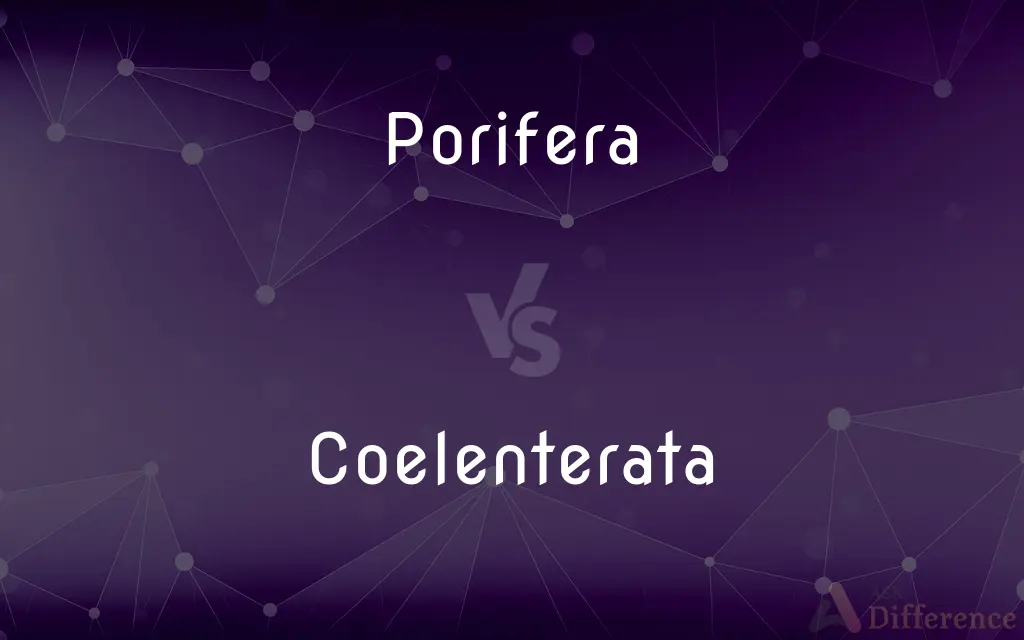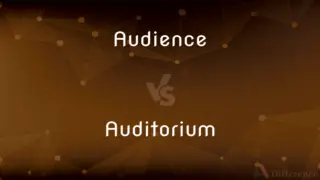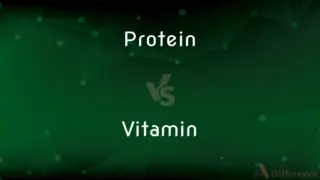Porifera vs. Coelenterata — What's the Difference?
By Tayyaba Rehman — Updated on September 25, 2023
Porifera is a phylum consisting mainly of sponges with porous bodies and no nervous system, while Coelenterata, or Cnidaria, includes jellyfish, corals, and sea anemones, characterized by a single body cavity and specialized cells for capturing prey.

Difference Between Porifera and Coelenterata
Table of Contents
ADVERTISEMENT
Key Differences
Porifera and Coelenterata are both classifications within the animal kingdom, each encompassing a diverse range of aquatic organisms. Porifera, more commonly known as sponges, are simple, multicellular organisms primarily found in marine environments. They are filter feeders, possessing pores throughout their bodies that allow water to pass through, facilitating the intake of nutrients and oxygen. Porifera do not have true tissues, organs, or a nervous system, indicating their primitive evolutionary status.
Coelenterata, also known as Cnidaria, includes marine animals like jellyfish, corals, and sea anemones. Unlike Porifera, organisms in this phylum have true tissues, including a simple nervous system, but lack specialized organs. They are characterized by radial symmetry and possess a single opening serving as both mouth and anus, leading to a gastrovascular cavity. Cnidarians are also known for their specialized stinging cells, or cnidocytes, which they use for capturing prey.
The comparison between Porifera and Coelenterata reveals distinct evolutionary advancements in the latter. While both primarily inhabit marine environments, Coelenterata displays more complexity with the presence of true tissues and a nervous system, absent in Porifera. Coelenterates also exhibit predatory behaviors, utilizing their specialized stinging cells to capture prey, contrasting the passive filter-feeding mechanism of Porifera.
Porifera’s simple structure and lack of specialized tissues demonstrate a more primitive evolutionary stage compared to Coelenterata. Poriferans are sessile, attaching themselves to substrates and relying on water flow for feeding and respiration. On the other hand, many Coelenterates can exhibit mobility, and their body structures are indicative of more advanced developmental processes, showcasing a greater degree of evolutionary complexity.
In conclusion, Porifera and Coelenterata represent different levels of evolutionary development within aquatic life forms. Porifera's simplistic and passive lifestyle contrasts markedly with the more developed, active, and specialized existence of organisms in the Coelenterata phylum.
ADVERTISEMENT
Comparison Chart
Body Structure
Simple, porous bodies without true tissues or organs.
Radially symmetrical bodies with true tissues.
Feeding Mechanism
Filter feeders, relying on water flow through pores.
Possess specialized stinging cells to capture prey.
Habitat
Mostly marine, some freshwater.
Primarily marine.
Examples
Sponges.
Jellyfish, Corals, Sea anemones.
Level of Complexity
Primitive, with no nervous system.
More advanced, with a simple nervous system.
Compare with Definitions
Porifera
Sessile animals lacking true tissues, a nervous system, and internal organs, primarily relying on filter feeding.
The lack of specialized structures in Porifera indicates their primitive evolutionary status.
Coelenterata
Animals with simple tissue organization, possessing a gastrovascular cavity serving both digestive and circulatory functions.
Coelenterata, with their unique body organization, are crucial for understanding the evolutionary development of tissue layers.
Porifera
Organisms primarily inhabiting marine environments, characterized by a sponge-like structure allowing water flow.
Porifera contribute to marine biodiversity, adapting to various underwater environments with their porous bodies.
Coelenterata
A phylum consisting of radially symmetrical aquatic animals such as jellyfish, corals, and sea anemones, characterized by a single body cavity and cnidocytes.
Coelenterata exhibit diverse forms and behaviors, from the floating jellyfish to the stationary coral colonies.
Porifera
A phylum comprising aquatic, mainly marine, sponges characterized by porous bodies and the absence of tissues and organs.
Porifera, with their simple, porous structure, play a crucial role in marine ecosystems, serving as habitat and filter feeders.
Coelenterata
Aquatic invertebrates characterized by radial symmetry and the presence of nematocysts, displaying different life cycle stages.
The life cycles of Coelenterata, involving both polyp and medusa stages, are indicative of their adaptive evolutionary strategies.
Porifera
The phylum encompassing sponges, exhibiting asymmetry and a lack of specialization in body structures.
Research on Porifera provides a window into the adaptive mechanisms of simple, multicellular life forms.
Coelenterata
Marine organisms known for their tentacles equipped with specialized stinging cells used for capturing prey.
Studying Coelenterata provides insights into the evolution of specialized cells and tissue structures in marine animals.
Porifera
Multicellular organisms known for their unique ability to draw water in through pores, filtering out food particles.
Studying Porifera offers insights into some of the earliest evolutionary developments in the animal kingdom.
Coelenterata
A group exhibiting a high degree of diversity in size, form, and ecological role, contributing significantly to marine biodiversity.
Coelenterata play varied roles in marine ecosystems, from forming coral reefs to serving as predators in the food chain.
Porifera
A grand division of the Invertebrata, including the sponges; - called also Spongiæ, Spongida, and Spongiozoa. The principal divisions are Calcispongiæ, Keratosa or Fibrospongiæ, and Silicea.
Coelenterata
Coelenterata is a term encompassing the animal phyla Cnidaria (coral animals, true jellies, sea anemones, sea pens, and their allies) and Ctenophora (comb jellies). The name comes from Ancient Greek: κοῖλος, romanized: koilos, lit. 'hollow' and ἔντερον, enteron, 'intestine', referring to the hollow body cavity common to these two phyla.
Porifera
Coextensive with the subkingdom Parazoa: sponges
Coelenterata
Hydras; polyps; jellyfishes; sea anemones; corals
Common Curiosities
Do Coelenterata have a central nervous system?
No, Coelenterata have a simple nervous system lacking a centralized structure.
Are Coelenterata important for marine ecosystems?
Yes, Coelenterata play crucial roles in marine ecosystems, contributing to biodiversity, forming coral reefs, and participating in food webs.
How do Coelenterata capture their prey?
Coelenterata use specialized stinging cells called cnidocytes located on their tentacles to capture prey.
Are all Porifera marine species?
While most Porifera species are marine, there are also some freshwater species.
Do Porifera have specialized organs?
No, Porifera lack specialized organs and true tissues.
What kind of symmetry do Coelenterata exhibit?
Coelenterata exhibit radial symmetry, meaning their body parts are arranged symmetrically around a central axis.
Are Porifera important for water filtration in aquatic environments?
Yes, Porifera play a crucial role in filtering water and maintaining water quality in aquatic ecosystems.
Can Porifera move?
Porifera are primarily sessile, meaning they are attached to substrates and do not exhibit movement.
Can Porifera regenerate their bodies?
Yes, many Porifera species can regenerate, allowing them to recover from injuries and reproduce asexually.
Are Porifera and Coelenterata considered advanced animal phyla?
No, both are considered primitive; Porifera are more primitive, lacking true tissues, whereas Coelenterata have more advanced features like true tissues and radial symmetry.
How do Porifera feed?
Porifera are filter feeders, extracting nutrients from water flowing through their porous bodies.
Can Coelenterata live in freshwater environments?
While primarily marine, some Coelenterata species, like certain hydra, can inhabit freshwater environments.
Do Coelenterata have a complex reproductive system?
Coelenterata exhibit a variety of reproductive strategies, including both asexual and sexual reproduction, but their systems are not as complex as those in more advanced phyla.
Are Porifera multicellular organisms?
Yes, Porifera are multicellular organisms, albeit with a simple body organization lacking true tissues.
Can Coelenterata exhibit bioluminescence?
Yes, some Coelenterata, like certain jellyfish species, can exhibit bioluminescence.
Share Your Discovery

Previous Comparison
Audience vs. Auditorium
Next Comparison
Protein vs. VitaminAuthor Spotlight
Written by
Tayyaba RehmanTayyaba Rehman is a distinguished writer, currently serving as a primary contributor to askdifference.com. As a researcher in semantics and etymology, Tayyaba's passion for the complexity of languages and their distinctions has found a perfect home on the platform. Tayyaba delves into the intricacies of language, distinguishing between commonly confused words and phrases, thereby providing clarity for readers worldwide.














































